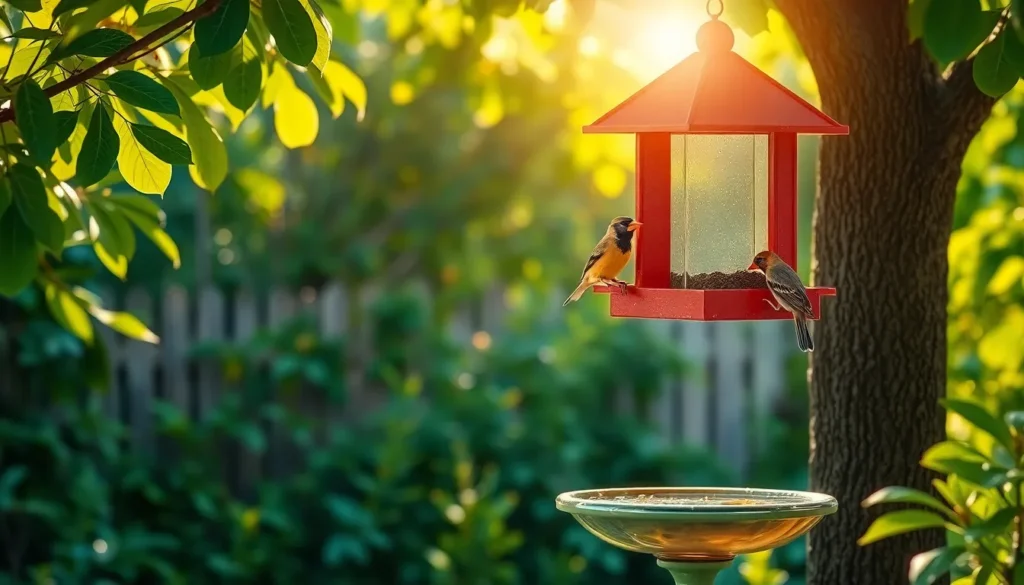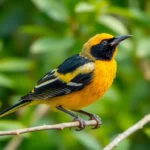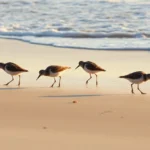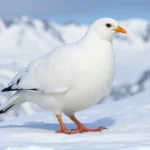We’ve all experienced that magical moment when colorful birds suddenly transform our backyard into a vibrant wildlife sanctuary. Bird feeders aren’t just simple garden accessories – they’re gateways to creating an enchanting network right outside our windows.
Whether you’re a seasoned birdwatcher or someone who simply enjoys nature’s beauty, choosing the right bird feeder can dramatically increase the variety and frequency of feathered visitors to your space. From attracting brilliant cardinals and cheerful goldfinches to hosting entire families of chickadees, the perfect feeder becomes an investment in year-round entertainment and natural wonder.
We’ll explore everything you need to know about selecting, positioning, and maintaining bird feeders that’ll turn your outdoor area into the neighborhood’s premier bird destination. Get ready to discover how this simple addition can bring joy, education, and countless hours of peaceful observation to your daily routine.
Choose the Right Type of Bird Feeder for Your Yard
We’ll guide you through selecting the perfect feeder to match your yard’s bird visitors and feeding preferences.
Tube Feeders for Small Songbirds
Tube feeders work perfectly for attracting chickadees, nuthatches, and titmice to your backyard sanctuary. These cylindrical feeders feature multiple feeding ports with small perches that accommodate birds weighing less than 2 ounces. We recommend choosing models with metal feeding ports since they resist damage from squirrels and larger birds.
Fill tube feeders with black oil sunflower seeds or safflower seeds for optimal results. The narrow design prevents seed waste while allowing easy access for small songbirds. Models with drainage holes keep seeds dry during rainy weather, extending seed freshness up to 2 weeks longer than feeders without proper ventilation.
Position tube feeders 5-6 feet above ground level for maximum safety and visibility. Small songbirds feel more secure feeding at this height, while the elevation makes it harder for ground predators to reach them.
Platform Feeders for Ground-Feeding Birds
Platform feeders attract cardinals, blue jays, and mourning doves that prefer feeding on flat surfaces. These open-tray style feeders mimic natural ground feeding conditions while keeping food elevated and clean. We suggest choosing platforms with raised edges to prevent seed spillage during windy conditions.
Stock platform feeders with cracked corn, millet, or mixed birdseed blends. The wide, flat surface accommodates multiple birds at once, creating an active feeding station that draws larger bird species. Drainage holes in the platform floor prevent water accumulation that could spoil seeds within 24-48 hours.
Mount platform feeders 3-4 feet high on poles or hang them from tree branches. This height range suits ground feeding birds while providing enough elevation to deter most ground predators like cats and raccoons.
Suet Feeders for Woodpeckers and Nuthatches
Suet feeders provide essential high fat nutrition for woodpeckers, nuthatches, and other clinging birds. These cage style feeders hold blocks of suet or fat mixed with seeds and nuts. We recommend metal mesh feeders over plastic versions since they withstand repeated pecking from strong woodpecker bills.
Offer suet feeders year round, but they’re especially valuable during fall and winter months. Cold weather increases birds’ caloric needs by 25-50%, making suet an crucial energy source. Commercial suet cakes contain 40-60% fat content, while homemade versions can be customized with preferred seeds and nuts.
Attach suet feeders directly to tree trunks or mount them on feeder poles. Woodpeckers and nuthatches naturally forage on vertical surfaces, so positioning feeders this way feels most natural to these specialized climbers.
Nyjer Feeders for Finches and Siskins
Nyjer feeders specifically target goldfinches, siskins, and other small seed eating birds through their tiny feeding ports. These specialized tube feeders feature holes small enough to dispense nyjer seed (also called thistle seed) without waste. We choose feeders with ports measuring 1/8 inch or smaller to prevent larger birds from accessing the expensive nyjer seed.
Stock nyjer feeders exclusively with fresh thistle seed for best attraction rates. Finches show strong preferences for nyjer seed over other options, with goldfinches consuming up to 14 grams daily during peak feeding times. Fresh seed maintains higher oil content, making it more appealing to finches than seed stored for over 6 months.
Hang nyjer feeders in open areas where finches can easily spot them while flying. These social birds often feed in flocks of 10-20 individuals, so positioning feeders away from dense cover allows them to maintain visual contact with flock members while feeding.
Select the Perfect Location for Your Bird Feeder
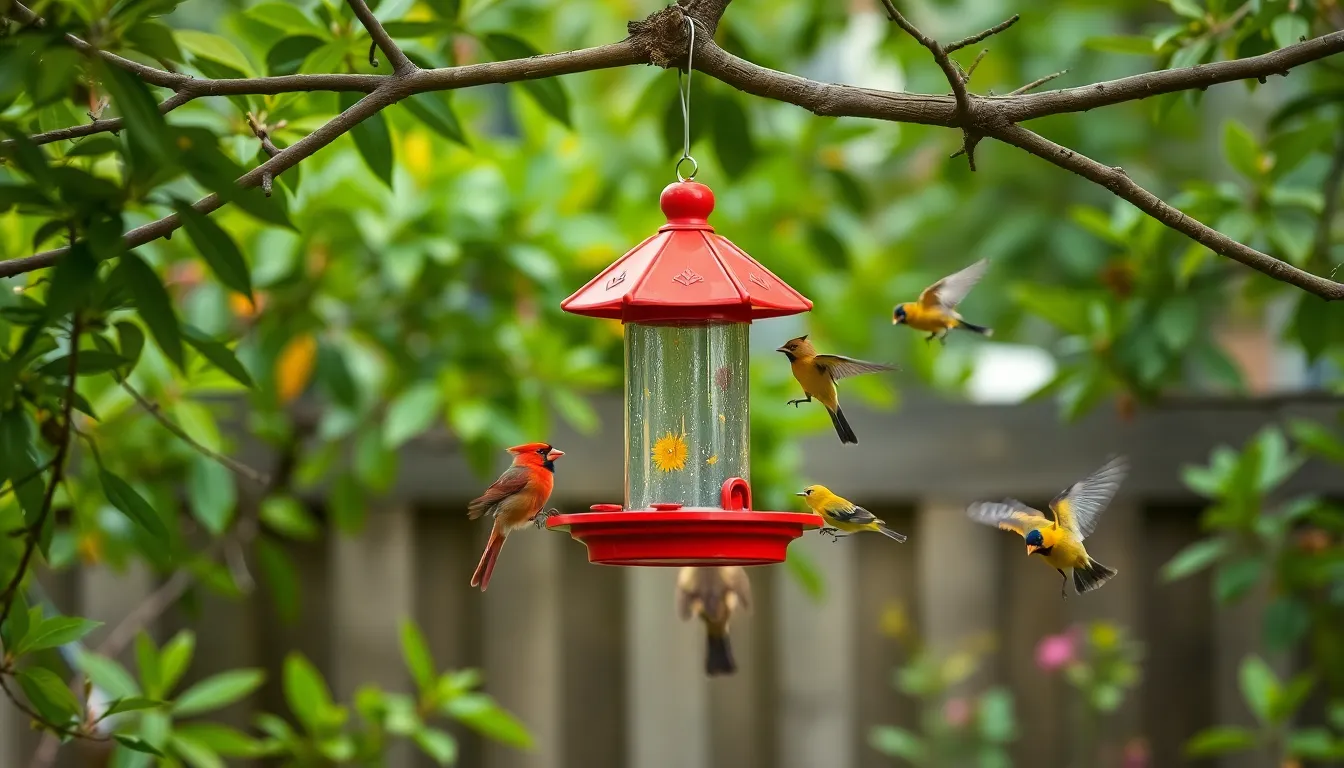
Choosing where to place your bird feeder makes the difference between an empty feeder and a bustling bird sanctuary. Strategic positioning protects our feathered visitors while maximizing our viewing pleasure.
Consider Safety from Predators
Position feeders at least 10 feet away from dense shrubs where cats and other predators hide. Open areas give birds clear escape routes and allow them to spot danger approaching from multiple directions.
Place feeders either within 3 feet of natural cover or more than 10 feet away to create the optimal safety zone. Birds need quick access to shelter but require enough distance to avoid ambush attacks from hidden predators.
Install feeders 5 to 6 feet above ground level to keep them out of reach from jumping cats and ground predators. This height also prevents squirrels from easily accessing the food while remaining accessible for most bird species.
Avoid positioning feeders near low branches that provide launching points for cats. Clear the area beneath feeders of fallen seeds regularly to prevent attracting rodents that draw predators to your bird feeding station.
Ensure Easy Visibility for Bird Watching
Select locations within 15 to 25 feet of your primary viewing window for optimal bird watching experiences. This distance allows clear observation of bird behavior while maintaining enough space to avoid startling nervous species.
Choose spots with natural lighting that illuminates the feeding area during peak morning and late afternoon hours. East facing positions capture beautiful morning light while west facing locations provide excellent evening viewing opportunities.
Position multiple feeders at varying heights and distances to create layered viewing experiences. Platform feeders work best closer to viewing areas while tube feeders can be placed farther away without losing visual appeal.
Install feeders where background vegetation creates contrast against bird colors and movement. Dense evergreen trees or dark fencing behind feeders make colorful birds like cardinals and goldfinches pop visually.
Maintain Proper Distance from Windows
Keep feeders either closer than 3 feet or farther than 30 feet from windows to prevent deadly bird strikes. The 3 to 30 foot range creates the most dangerous zone where birds build up fatal momentum before impact.
Install feeders directly against window glass using suction cup mounts for the safest close proximity option. Birds approaching these feeders move slowly and rarely sustain serious injuries from gentle contact with glass.
Place decals or screens on nearby windows when feeders must be positioned in the danger zone. These visual markers help birds recognize glass barriers and adjust their flight patterns accordingly.
Consider window strike statistics showing that over 600 million birds die annually from glass collisions in North America. Proper feeder placement significantly reduces our contribution to this preventable wildlife tragedy.
Fill Your Bird Feeder with the Best Seeds and Foods
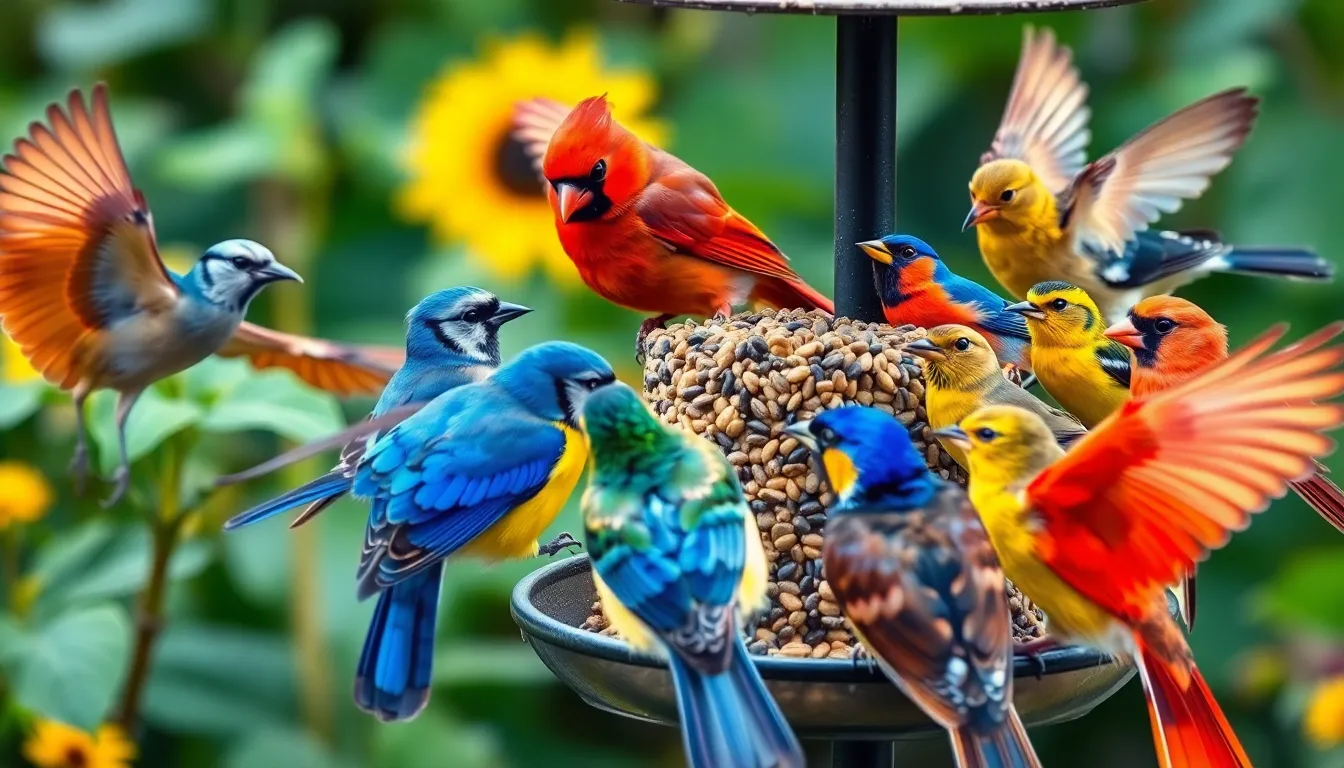
Choosing the right food for your bird feeders makes all the difference in attracting diverse bird species. We’ve found that the quality and type of seed you select directly impacts which birds visit your backyard sanctuary.
Black Oil Sunflower Seeds for Universal Appeal
Black oil sunflower seeds serve as the gold standard for bird feeding enthusiasts across North America. We recommend these seeds because they attract over 40 bird species, including cardinals, chickadees, nuthatches, and woodpeckers. Their thin shells make them easy for birds to crack open, while their high fat content provides essential energy year-round.
Benefits of black oil sunflower seeds:
| Feature | Benefit |
|---|---|
| High fat content (28%) | Provides essential energy for birds |
| Thin shells | Easy for most bird species to crack |
| All-season appeal | Attracts birds throughout the year |
| Universal acceptance | Appeals to 40+ bird species |
Cardinals show particular preference for these seeds, often becoming regular visitors within days of filling your feeder. We’ve observed that goldfinches, blue jays, and even smaller songbirds like wrens will readily consume black oil sunflower seeds when other food sources become scarce.
Mixed Seed Blends for Variety
Mixed seed blends offer an economical way to attract multiple bird species with a single feeder filling. We suggest selecting blends that contain primarily sunflower seeds, millet, and safflower seeds while avoiding fillers like milo and cracked corn that many birds reject.
Quality mixed blends typically include:
- White millet for ground-feeding birds like juncos and sparrows
- Safflower seeds to deter squirrels while attracting cardinals
- Peanut pieces for woodpeckers and jays
- Thistle seed for finches and siskins
Premium blends cost 15-20% more than standard mixes but reduce waste significantly because birds consume nearly every seed. We’ve noticed that cheaper blends often contain up to 40% filler ingredients that birds scatter on the ground, creating cleanup issues and potentially attracting unwanted rodents.
Specialty Foods for Exact Bird Species
Specialty foods allow us to target exact bird species and create a more diverse backyard bird community. These targeted offerings often produce dramatic results in attracting particular species that might otherwise ignore standard seed mixes.
Nyjer seed attracts goldfinches, siskins, and pine siskins with remarkable consistency. We place nyjer in specialized tube feeders with small ports that prevent larger birds from monopolizing the food supply. Fresh nyjer seed produces better results than older stock, so we purchase it in smaller quantities and store it in cool, dry conditions.
Suet cakes provide essential high-fat nutrition that woodpeckers, nuthatches, and creepers require, especially during winter months. We’ve found that homemade suet using beef fat mixed with peanut butter and cornmeal attracts more species than commercial varieties. Suet feeders should be placed on tree trunks or wooden posts to accommodate woodpeckers’ natural feeding behavior.
Peanuts in the shell create excitement among blue jays, woodpeckers, and squirrels alike. We scatter unsalted, raw peanuts on platform feeders or thread them onto specialized peanut feeders. Jays often cache these peanuts for later consumption, helping to distribute seeds and support forest regeneration naturally.
Mealworms appeal to insect-eating birds like bluebirds, wrens, and robins that rarely visit seed feeders. We offer dried mealworms in shallow dishes placed near shrubs where these species feel secure while feeding. Fresh mealworms work even better but require more careful storage and handling.
Maintain Your Bird Feeder for Optimal Bird Health
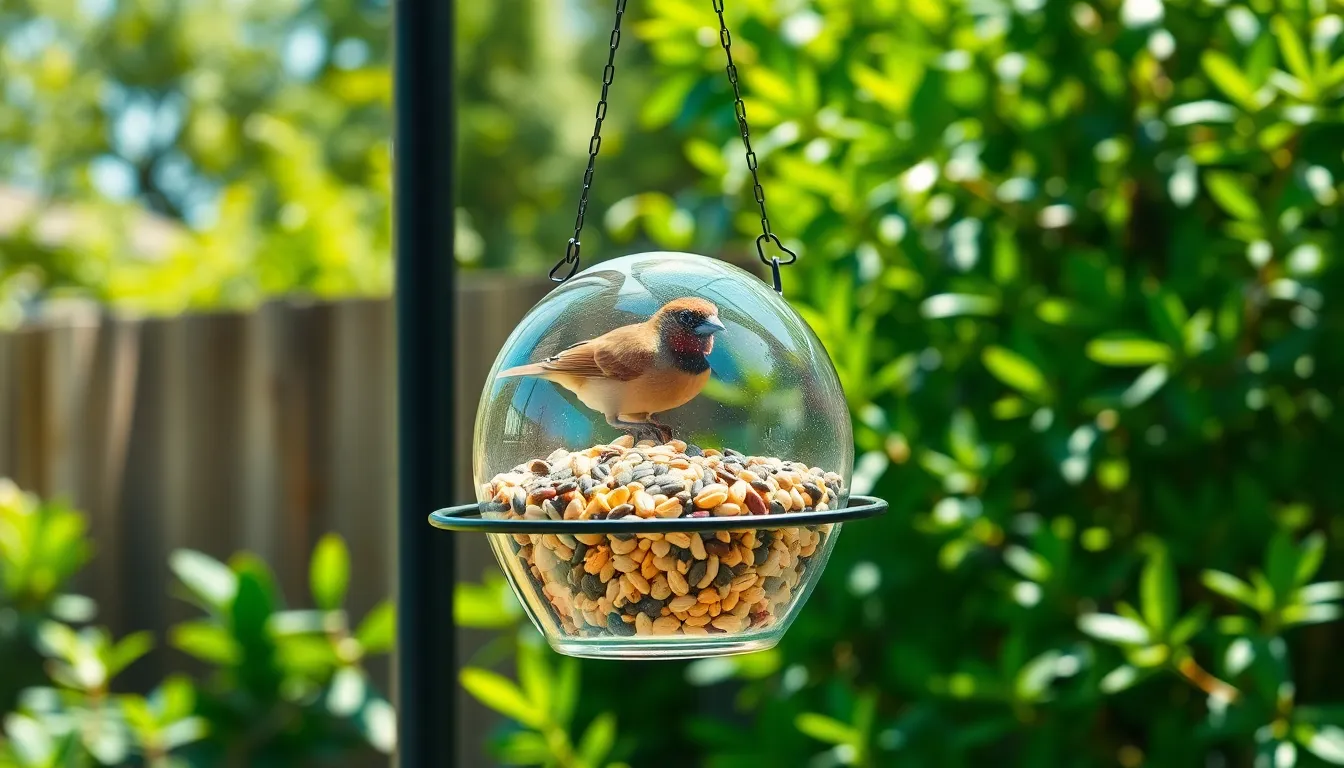
Clean feeders prevent harmful bacteria and disease from spreading through your backyard bird community. Regular maintenance ensures birds stay healthy while enjoying the quality foods we’ve carefully selected for their nutritional needs.
Clean Feeders Every Two Weeks
Empty your bird feeder completely before beginning the cleaning process to remove all remaining seeds and debris. Remove the feeder from its mounting position and take apart all removable components like perches, seed trays, and feeding ports. Scrub each piece thoroughly using warm soapy water and a bottle brush to reach tight corners where bacteria often accumulate.
Rinse all components with clean water after washing to eliminate soap residue that could harm visiting birds. Allow every piece to air dry completely in direct sunlight, which naturally helps kill remaining germs and prevents moisture buildup. Reassemble your feeder only when all parts are completely dry to avoid trapping moisture inside.
Replace worn or cracked pieces during your regular cleaning routine to maintain structural integrity and prevent food contamination. Check feeding ports for damage that might allow water to enter or create sharp edges that could injure birds. Store backup parts or consider purchasing a replacement feeder if repairs become frequent.
Remove Old or Moldy Food Promptly
Inspect your bird feeder daily for signs of spoiled or moldy food that could make birds sick or even cause death. Look for discolored seeds, white fuzzy growth, or clumping that indicates moisture damage and bacterial growth. Remove contaminated food immediately using gloves and dispose of it in your regular trash.
Check seed freshness weekly by examining the color and smell of stored birdseed before refilling your feeders. Fresh seeds maintain their natural color and have a pleasant nutty aroma, while rancid seeds appear dull and smell sour or musty. Purchase smaller quantities of quality bird food more frequently rather than buying in bulk to ensure optimal freshness.
Monitor weather conditions that accelerate food spoilage, particularly during humid summer months or extended rainy periods. Empty feeders completely after storms and replace wet seed that could develop dangerous mold within 24 to 48 hours. Consider using feeders with better drainage or weather protection during challenging seasons.
Disinfect with Bleach Solution Monthly
Mix one part household bleach with nine parts water to create an effective disinfecting solution that kills harmful bacteria and viruses. Use only regular unscented bleach without additives or fragrances that could leave toxic residues on feeder surfaces. Prepare fresh solution monthly since bleach loses effectiveness over time when exposed to light and air.
Soak all feeder parts in the bleach solution for 10 to 15 minutes to eliminate stubborn pathogens that regular washing might miss. Focus extra attention on feeding ports, perches, and drainage holes where birds make direct contact during feeding. Use a soft brush to scrub away any remaining debris during the soaking process.
Rinse thoroughly with clean water after disinfecting to remove all bleach residue that could harm birds or affect food taste. Allow components to air dry completely in sunlight before reassembling your bird feeder for use. Never mix bleach with other cleaning products, as this creates dangerous chemical reactions that could produce toxic gases.
Position Multiple Bird Feeders to Attract More Species
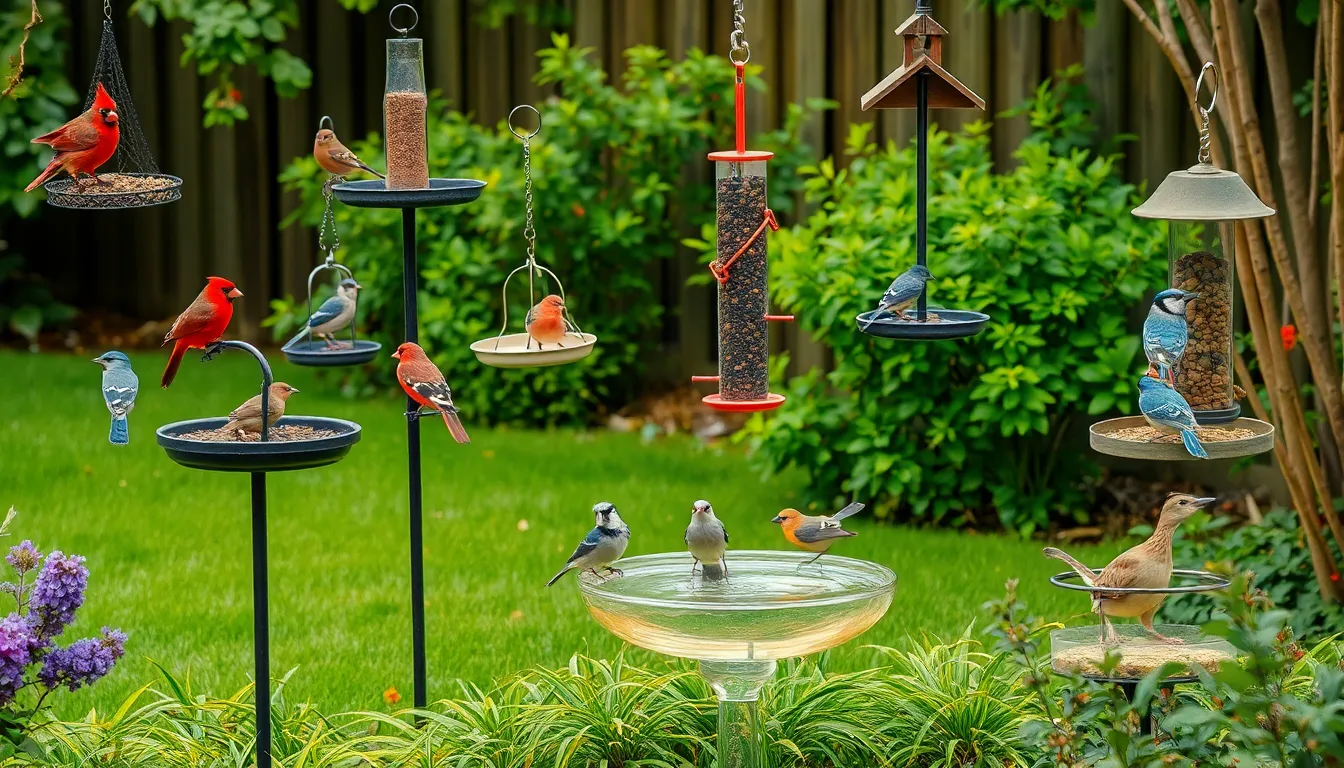
Strategic feeder placement throughout your yard creates diverse dining opportunities that appeal to different bird species and their unique feeding behaviors.
Space Feeders at Different Heights
Birds naturally feed at various elevations in the wild, so we should replicate this vertical diversity in our backyards. Ground level platform feeders attract cardinals, sparrows, and juncos who prefer to forage near the earth’s surface. Mid level feeders positioned 4 to 6 feet high serve chickadees, nuthatches, and titmice that typically search for food in shrubs and lower tree branches.
Higher feeders mounted 8 to 12 feet up appeal to woodpeckers, blue jays, and finches who naturally feed in tree canopies. This vertical spacing prevents competition between species and allows multiple birds to feed simultaneously without territorial disputes.
We recommend maintaining at least 8 feet between feeders at different heights to give each species adequate space. This arrangement mimics natural forest layers and encourages more diverse bird communities to visit your yard regularly.
Create Feeding Stations Throughout Your Yard
Multiple feeding stations positioned strategically across your property accommodate different bird personalities and social structures. Shy species like hermit thrushes prefer quiet, secluded areas near dense vegetation where they feel protected while feeding. Social birds such as goldfinches and house finches thrive at stations in open areas where they can feed in flocks.
Corner locations work exceptionally well for feeding stations because they provide natural boundaries that help birds feel secure. We suggest placing stations at least 20 feet apart to reduce overcrowding and territorial behavior between dominant species like blue jays and smaller songbirds.
Each station should include 2 to 3 different feeder types to maximize species diversity. Pairing a tube feeder with a platform feeder and suet cage creates comprehensive dining options that attract seed eaters, ground feeders, and insect loving birds simultaneously.
Combine Feeders with Water Sources
Water features near feeding stations create irresistible bird magnets that significantly increase visitor numbers and species diversity. Shallow birdbaths positioned 3 to 5 feet from feeders provide convenient drinking and bathing opportunities that birds need daily. Moving water sources like drippers or small fountains produce sounds that attract birds from greater distances than still water.
During winter months, heated birdbaths become essential when natural water sources freeze over. We’ve observed that yards with both food and water sources attract 40% more bird species than those with feeders alone.
Placement timing matters significantly for water and feeder combinations. Morning positioning in eastern exposure areas catches early sunlight that warms water naturally and creates appealing steam effects that birds find attractive. This strategic combination transforms simple feeding areas into comprehensive bird habitats that support diverse avian communities throughout all seasons.
Protect Your Bird Feeder from Squirrels and Other Pests
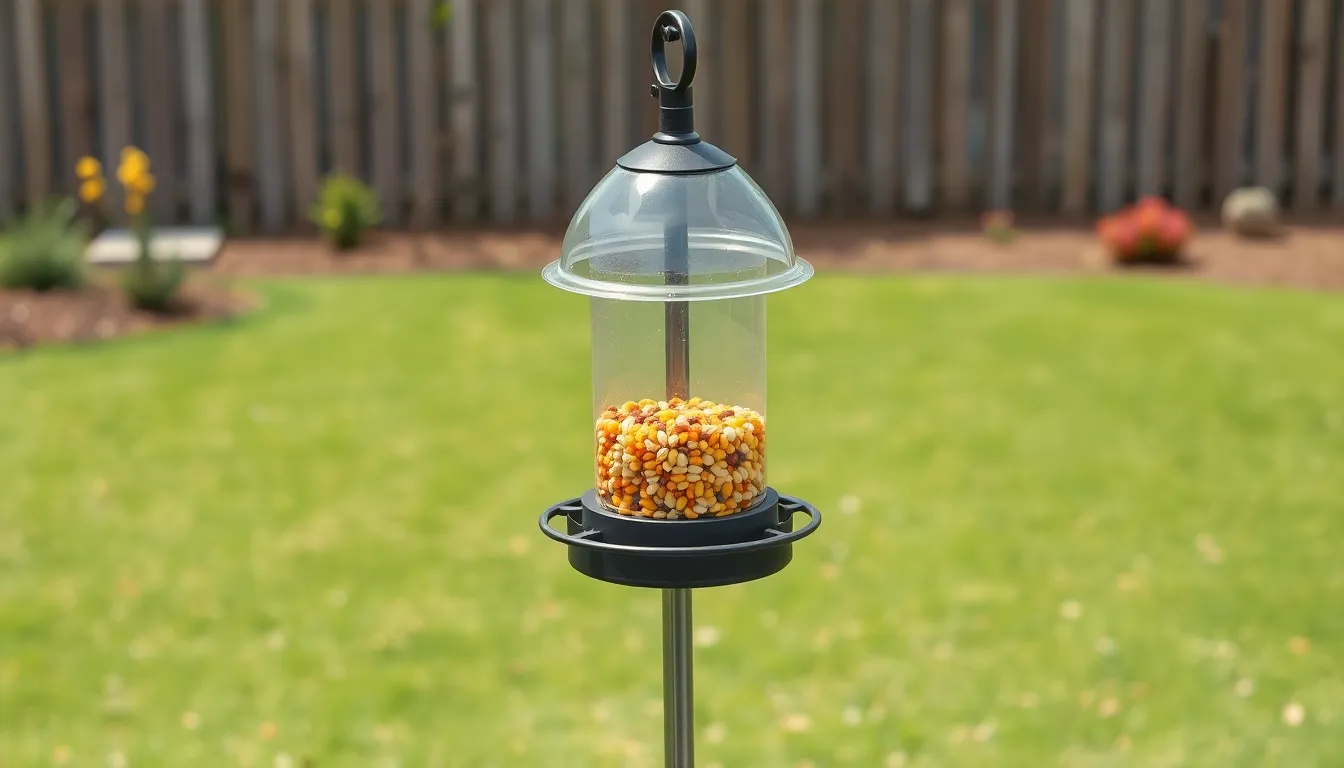
While we’ve established the perfect feeding environment for birds, protecting these investments from persistent squirrels and other unwanted visitors becomes essential for maintaining a thriving bird sanctuary. Effective pest prevention ensures our feathered friends get the nutrition they need without competition from opportunistic mammals.
Install Squirrel-Proof Baffles
Baffles create the most reliable defense against squirrels attempting to raid our bird feeders. We recommend installing dome-shaped baffles above hanging feeders, positioning them at least 18 inches from the feeder to prevent squirrels from reaching around them. Pole-mounted baffles work exceptionally well when placed 4 to 5 feet above ground level on feeding station posts.
Wraparound baffles offer superior protection for pole-mounted systems, creating a smooth cylindrical barrier that squirrels can’t grip or climb past. We suggest choosing baffles made from powder-coated steel or heavy-duty plastic that won’t crack in extreme weather conditions. Clear acrylic baffles provide pest protection while maintaining visibility of approaching birds.
Weight-activated mechanisms add another layer of squirrel deterrence by closing feeding ports when animals heavier than birds attempt to feed. These feeders typically activate when detecting weights over 1.5 ounces, effectively blocking squirrels while allowing cardinals and other medium-sized birds to feed comfortably.
Use Safflower Seeds as Natural Deterrent
Safflower seeds provide an excellent natural solution for discouraging squirrels while continuing to attract desirable bird species. We’ve found that squirrels dislike the bitter taste of safflower seeds, making them avoid feeders filled with this alternative food source. Cardinals, chickadees, nuthatches, and house finches readily consume safflower seeds, ensuring our feeders remain active with bird visitors.
Transitioning from sunflower seeds to safflower requires patience, as birds may need several days to accept the new food option. We recommend mixing safflower seeds with familiar foods initially, gradually increasing the safflower ratio over two weeks until feeders contain 100% safflower seeds.
Pure safflower seed feeders experience significantly less squirrel activity compared to traditional mixed seed options. These white, angular seeds cost slightly more than sunflower seeds but prove economical by reducing waste from squirrel consumption and spillage.
Position Feeders Away from Jumping Points
Strategic feeder placement creates effective barriers against squirrels using their impressive jumping abilities to access food sources. We position our feeders at least 10 feet away from trees, fences, decks, or other structures that squirrels use as launching platforms. Squirrels can jump horizontally up to 8 feet and leap down from heights of 10 feet or more.
Isolated pole systems work best when placed in open yard areas where squirrels can’t approach from multiple angles. We install these feeding stations at least 6 feet high and ensure surrounding grass remains short to eliminate hiding spots for approaching pests.
Creating buffer zones around feeders involves removing or trimming nearby branches that extend within jumping range. We maintain at least 12 feet of clearance from overhanging tree limbs to prevent squirrels from dropping directly onto feeders from above.
Ground clearance becomes crucial for preventing raccoons and cats from climbing feeder poles. We keep at least 5 feet of smooth pole below the lowest baffle, making it impossible for these larger pests to gain enough grip to climb toward the feeding area.
Time Your Bird Feeder Filling for Maximum Activity
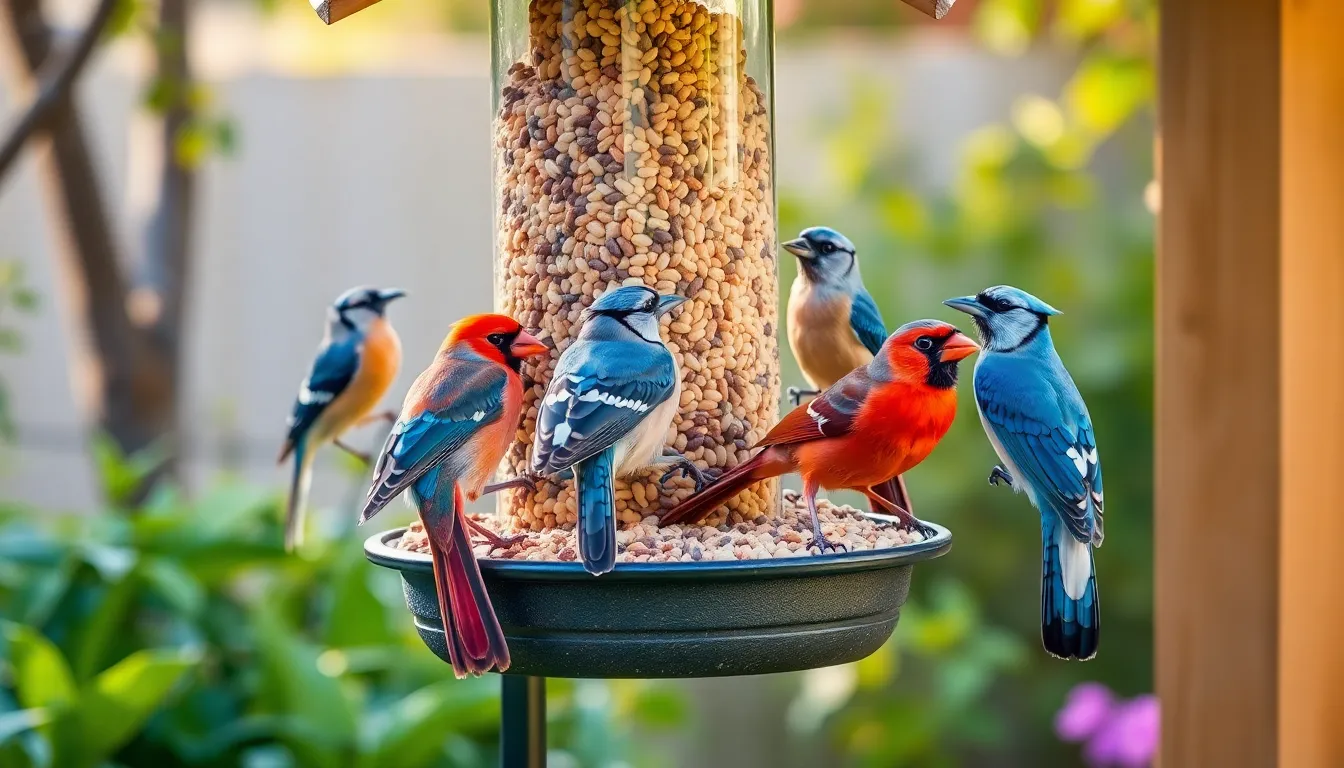
Strategic timing of your bird feeder refills can dramatically increase the number and variety of birds visiting your backyard sanctuary. We’ll explore how to synchronize your feeding schedule with natural bird behavior patterns to maximize activity and enjoyment.
Fill Feeders Early Morning for Peak Feeding
Early morning hours between 6:00 AM and 8:00 AM represent the most active feeding period for backyard birds. Birds wake up with empty stomachs after overnight fasting and immediately search for high energy foods to fuel their day. We recommend filling your tube feeders, platform feeders, and suet feeders before sunrise to capture this peak activity window.
Dawn feeding sessions attract the widest variety of species including cardinals, blue jays, chickadees, and nuthatches. Research shows that 75% of daily bird feeder visits occur within the first three hours of daylight. Morning temperatures are cooler which means birds need extra calories to maintain their body heat from the previous night.
Fresh food in clean feeders during these early hours creates an inviting environment that birds remember and return to throughout the day. We suggest checking your feeders the night before to ensure they’re adequately stocked for the morning rush.
Maintain Consistent Feeding Schedule
Consistent refilling schedules help birds establish reliable feeding patterns and increase their dependence on your backyard food sources. Birds develop memory patterns around food availability and will visit feeders at expected times when they know fresh food is present. We recommend establishing a regular schedule that works with your daily routine.
Weekly refilling works well for most bird feeders depending on the number of visiting birds and feeder capacity. High traffic areas may require refilling every 3 to 4 days to prevent empty feeders that frustrate hungry birds. Document which feeders empty fastest to adjust your schedule accordingly.
Predictable food availability reduces stress for birds and creates a dependable food source they can count on. Inconsistent filling leads to decreased bird visits as they seek more reliable feeding locations elsewhere in the neighborhood.
Adjust for Seasonal Migration Patterns
Spring migration from March to May brings increased bird activity as species return from southern wintering grounds and seek high energy foods. We need to increase our feeding frequency during these months to accommodate larger numbers of hungry travelers. Mixed seed blends and black oil sunflower seeds become especially important during migration periods.
Fall migration from August to October creates another peak feeding period as birds prepare for long journeys south. Suet cakes and high fat foods help birds build energy reserves needed for migration. Many species will visit feeders more frequently to stock up before departing.
Winter months require the most consistent feeding schedule as natural food sources become scarce. Birds depend heavily on backyard feeders during December through February when insects and seeds are buried under snow. Summer feeding may decrease as natural food abundance increases but maintaining some level of feeding keeps birds familiar with your location.
Migration timing varies by geographic region so we should research local bird migration patterns to optimize our feeding schedules for maximum effectiveness.
Enhance Your Bird Feeder Setup with Natural Elements
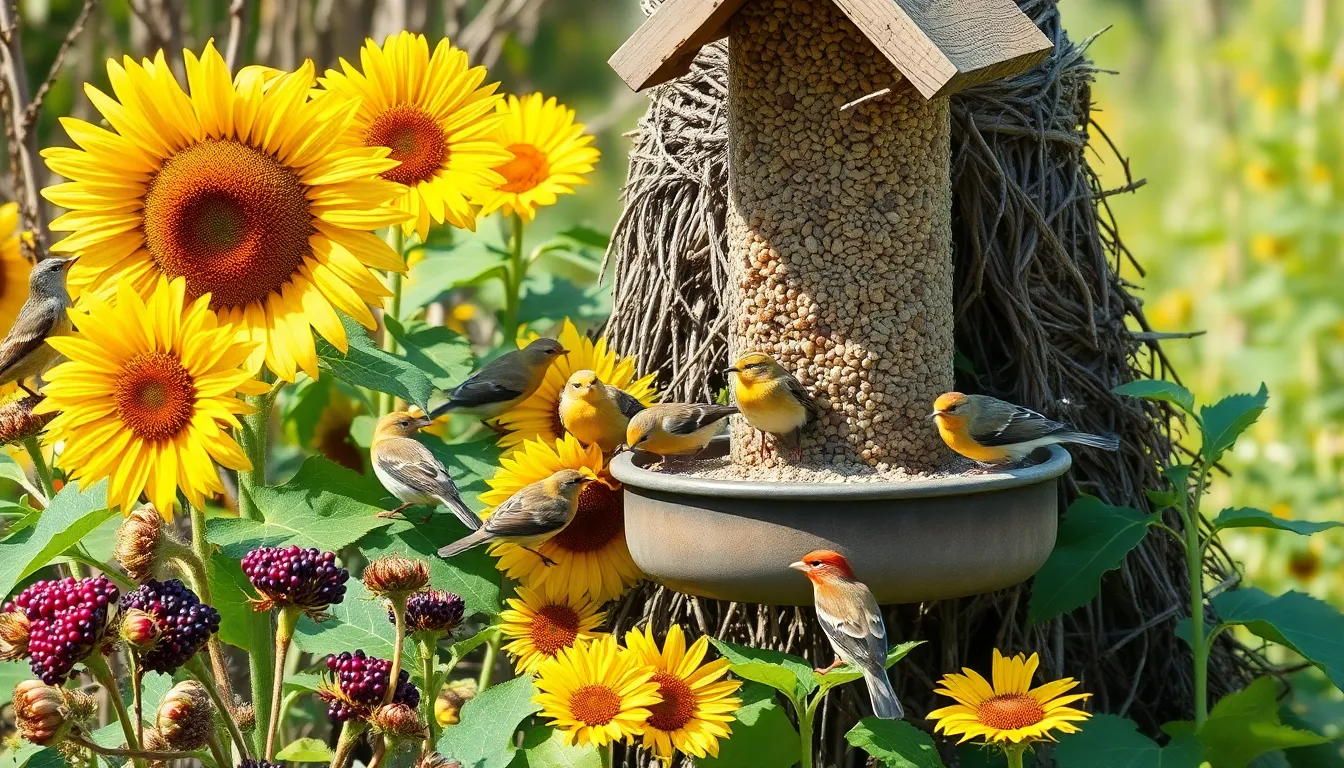
Natural elements around your bird feeding stations create a more inviting environment that birds instinctively seek. We’ll explore how to integrate native plants, nesting materials, and shelter options that complement your existing feeder setup.
Add Native Plants for Cover and Food
Native plants serve as natural magnets for birds while providing essential cover near feeding areas. We recommend planting elderberry bushes, serviceberry trees, and native sunflowers within 10 to 15 feet of your feeders to create a seamless transition between natural and supplemental food sources.
Berry-producing shrubs like dogwood and sumac offer year-round food sources that extend beyond what traditional feeders provide. These plants attract over 30 bird species including thrushes, waxwings, and mockingbirds that might otherwise bypass standard seed feeders.
Seed-producing flowers such as black-eyed Susans, purple coneflowers, and native grasses create natural foraging opportunities throughout the growing season. Birds can harvest seeds directly from these plants during late summer and fall months when natural food sources become scarce.
Dense shrubs and small trees positioned strategically around feeding areas provide crucial escape routes when predators appear. We suggest creating layered plantings with ground-level plants, mid-height shrubs, and taller trees to accommodate different bird species’ comfort zones.
Provide Nesting Materials Nearby
Natural nesting materials placed near bird feeders encourage birds to establish territories in your yard throughout breeding season. We recommend creating a dedicated nesting material station using a suet cage filled with natural fibers, pet fur, and small twigs.
Cotton batting, sheep’s wool, and dried grasses appeal to species like goldfinches and house finches that prefer soft materials for lining their nests. Position these materials 15 to 20 feet from active feeding stations to prevent interference during busy feeding periods.
Small branches, strips of bark, and dried leaves attract larger birds such as robins and blue jays that construct more substantial nest structures. We suggest bundling these materials loosely in mesh bags or shallow baskets for easy bird access.
Hair from brushing pets provides excellent insulation material that many songbirds incorporate into their nests. Fresh hair works better than processed materials and should be offered in small quantities to prevent birds from becoming entangled.
Create Brush Piles for Shelter
Brush piles offer essential shelter and protection that complement your feeding stations during harsh weather conditions. We build these structures using fallen branches, pruned limbs, and natural debris positioned 20 to 30 feet from active feeders.
Layered construction creates multiple entry points and hiding spots that accommodate birds of different sizes. Start with larger branches as the foundation and add progressively smaller twigs and brush to create a dense shelter matrix.
Strategic placement near feeding areas gives birds quick access to protection when hawks or other predators threaten the feeding zone. These refuge spots reduce stress and encourage more frequent visits to your bird feeders throughout the day.
Winter brush piles become particularly valuable when natural cover disappears and birds need protection from wind and precipitation. We refresh these shelters seasonally by adding new material and removing decomposed branches that no longer provide adequate cover.
Monitor Your Bird Feeder for Wildlife Safety
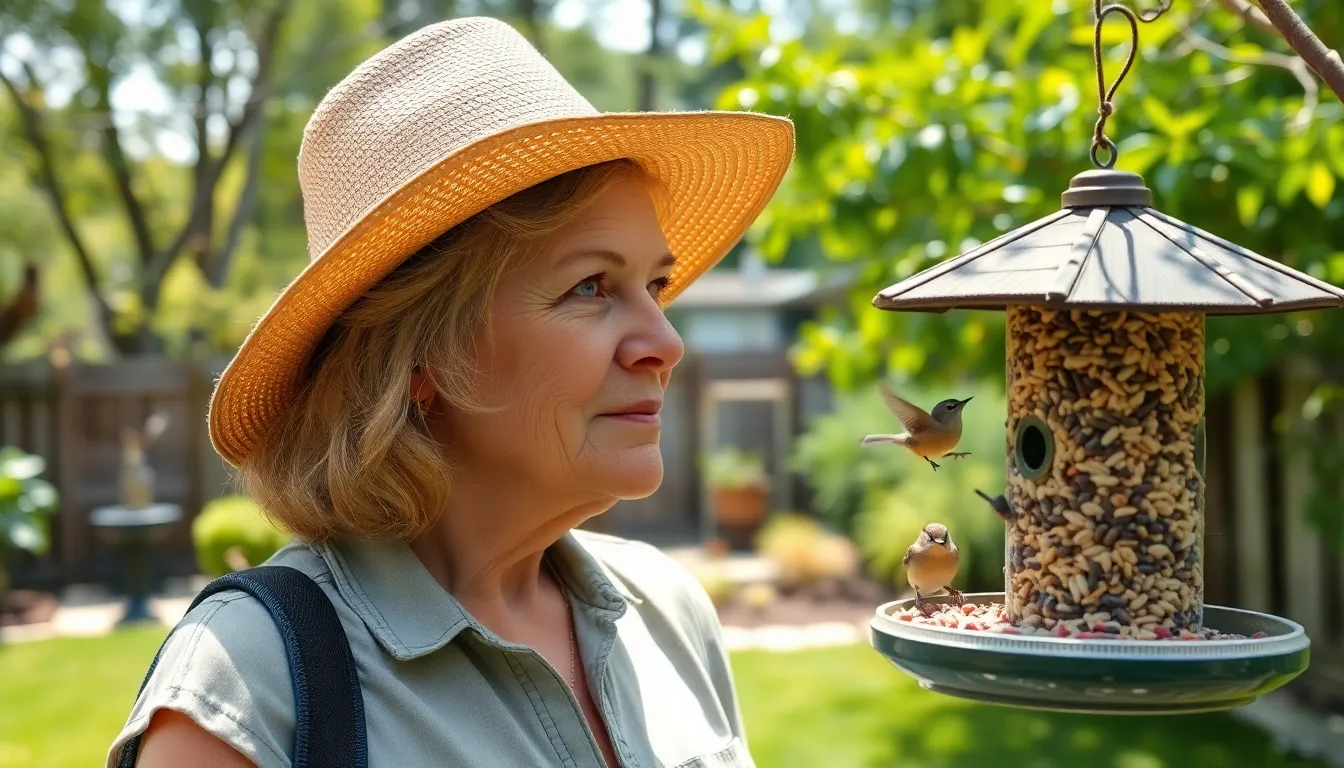
Monitoring bird feeders goes beyond enjoying visits from feathered friends. We need to stay vigilant about potential safety issues that could harm the bird populations we’re working to support.
Watch for Signs of Disease Spread
Disease transmission at bird feeders poses a serious threat to local bird populations. We should watch for sick birds that appear lethargic, have fluffed feathers, or show unusual behavior like sitting motionless near feeders for extended periods. Birds with swollen or crusty eyes, discharge from their beaks, or difficulty flying may indicate avian conjunctivitis or other infectious diseases.
Dead birds around our feeding stations require immediate attention. We need to remove deceased birds promptly using gloves or tools to avoid direct contact. Multiple bird deaths within a short timeframe signal a potential disease outbreak that demands immediate feeder shutdown.
Overcrowding at feeders increases disease transmission risks significantly. We can reduce this hazard by spreading multiple feeders throughout our yard rather than concentrating them in one area. Cleaning feeders with a 10% bleach solution becomes critical when we observe any signs of illness among our bird visitors.
Remove Feeders During Window Strikes
Window strikes represent one of the leading causes of bird mortality near residential feeders. We must temporarily remove feeders when birds repeatedly collide with windows in our feeding areas. Moving feeders to different locations often solves collision problems without eliminating feeding opportunities entirely.
Birds strike windows most frequently during migration seasons when unfamiliar species pass through our yards. We should consider removing feeders for 2-3 weeks during peak spring and fall migration periods if strikes become frequent. This temporary measure allows migrating birds to find alternative routes around our property.
Installing bird strike prevention measures works better than permanent feeder removal. We can apply decals, screens, or tape to problem windows while keeping feeders active. Repositioning feeders either within 3 feet or beyond 30 feet from windows dramatically reduces collision rates according to wildlife safety studies.
Report Unusual Bird Behavior to Authorities
Reporting unusual bird behavior helps wildlife authorities track disease outbreaks and environmental threats. We should contact local wildlife agencies when observing large numbers of disoriented, sick, or dead birds around our feeders. State wildlife departments and the National Wildlife Health Center collect this data to monitor bird population health trends.
Unusual migration patterns or species appearing outside their normal ranges warrant reporting to eBird or local birding organizations. We contribute valuable scientific data when we document these observations with dates, locations, and exact behaviors. This information helps researchers understand climate change impacts and habitat shifts affecting bird populations.
Aggressive behavior between bird species at feeders sometimes indicates territorial disputes over limited resources. We need to report extreme aggression that results in injuries or prevents normal feeding patterns. Wildlife biologists use this information to understand competition dynamics and recommend feeding strategies that reduce conflicts.
Conclusion
Creating a thriving bird-friendly backyard isn’t just about hanging up a feeder and hoping for the best. We’ve explored the essential elements that transform ordinary outdoor spaces into vibrant wildlife sanctuaries – from selecting the right feeder types and premium foods to mastering strategic placement and maintenance routines.
The key to success lies in understanding that every detail matters. When we combine proper feeder positioning with consistent cleaning schedules and natural habitat enhancements we’re not just feeding birds – we’re building lasting relationships with our feathered neighbors.
Most importantly we’re contributing to wildlife conservation while enriching our own lives. The peaceful moments spent watching cardinals at dawn or hearing the cheerful chatter of chickadees make every effort worthwhile. With these proven strategies you’re well-equipped to create your own backyard bird paradise.
Frequently Asked Questions
What types of bird feeders should I use to attract different bird species?
Different feeders attract different birds. Tube feeders work best for small songbirds like chickadees and nuthatches. Platform feeders attract ground-feeding birds such as cardinals and blue jays. Suet feeders are perfect for woodpeckers during colder months. Nyjer feeders specifically target finches and siskins with specialized thistle seed dispensing ports.
Where should I place my bird feeders for optimal bird visits?
Position feeders at least 10 feet from dense shrubs to protect birds from predators, and 5-6 feet above ground to deter cats and squirrels. Place them 15-25 feet from viewing windows for best observation. Keep feeders either closer than 3 feet or farther than 30 feet from windows to prevent bird strikes.
What are the best foods to put in bird feeders?
Black oil sunflower seeds are the universal favorite, attracting over 40 bird species due to their high fat content and easy-to-crack shells. Mixed seed blends attract multiple species economically. Specialty foods like nyjer seeds, suet cakes, peanuts, and mealworms target specific birds and enhance backyard diversity.
How often should I clean my bird feeders?
Clean feeders every two weeks by emptying them completely and scrubbing all components with warm soapy water. Check daily for old or moldy food and replace immediately. Perform monthly disinfection using a diluted bleach solution, then rinse thoroughly and air dry in sunlight before reassembly.
How can I protect my bird feeders from squirrels?
Install squirrel-proof baffles above hanging feeders and use weight-activated mechanisms to deter larger animals. Use safflower seeds as a natural deterrent since squirrels dislike the taste. Place feeders away from jumping points and create buffer zones around them to prevent access.
When is the best time to refill bird feeders?
Early morning hours between 6:00 AM and 8:00 AM are peak feeding times when birds are most active. Fill feeders before sunrise to attract the widest variety of species. Maintain a consistent feeding schedule and adjust for seasonal migration patterns during spring and fall.
Should I have multiple bird feeders in my yard?
Yes, positioning multiple feeders at different heights attracts more species. Ground-level platform feeders serve cardinals and sparrows, mid-level feeders attract chickadees and nuthatches, and higher feeders appeal to woodpeckers and finches. This reduces competition and accommodates different bird personalities and feeding preferences.
What natural elements should I add near my bird feeders?
Plant native plants like elderberry bushes and serviceberry trees near feeders for cover and food sources. Add berry-producing shrubs and seed-producing flowers to attract more species. Provide nesting materials like natural fibers and small twigs nearby, and create brush piles for shelter and predator protection.
How do I monitor bird feeders for wildlife safety?
Watch for signs of disease among birds like lethargy or unusual behavior. Remove deceased birds promptly and spread feeders throughout the yard to reduce overcrowding. Temporarily remove feeders during peak migration seasons to prevent window strikes. Report unusual bird behavior to wildlife authorities.
Do I need to provide water sources near my bird feeders?
Yes, combining feeders with water sources like birdbaths or fountains significantly increases bird visitation. Yards with both food and water attract more species than those with feeders alone. Water sources are essential for drinking and bathing, making your backyard more attractive to diverse bird communities.

